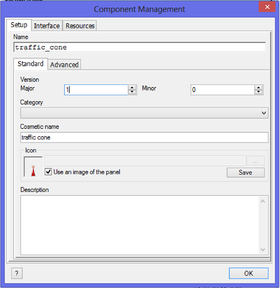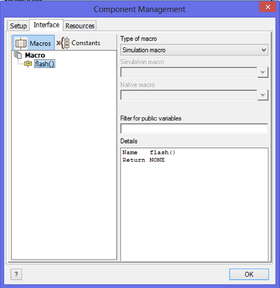Difference between revisions of "Exercise - Exporting the Traffic Cone Component"
From Flowcode Help
Jump to navigationJump to searchJohnVerrill (talk | contribs) (Created page with "==Preliminaries== 280px|right * Create a traffic cone component as shown in the Exercise - Create a LED component. =...") |
|||
| (22 intermediate revisions by 2 users not shown) | |||
| Line 1: | Line 1: | ||
| + | <sidebar>Sidebar: Flowcode Exercises:Ex3</sidebar> | ||
| + | Now that we have created the traffic cone component in the previous [[Exercise - Building a Complex Component]] article we can now export the component (which also contains the 'newLED' component we created earlier) for use elsewhere. | ||
| + | |||
| + | __NOTOC__ | ||
==Preliminaries== | ==Preliminaries== | ||
| − | [[File: | + | [[File:gen_exerciseconeexport_compmansetup_01.png|280px|right]] |
| − | * Create a traffic cone component as shown in the [[Exercise - | + | * Create a traffic cone component as shown in the [[Exercise - Building a Complex Component|Exercise - Building a Complex Component - the Traffic Cone]] article. |
| Line 8: | Line 12: | ||
==Declaring the interface== | ==Declaring the interface== | ||
| − | Before you export a component, you need to 'declare the interface'. | + | Before you export a component, you need to 'declare the interface'. |
| − | |||
| − | |||
* Move the mouse cursor over the [[System Panel]], and right-click. | * Move the mouse cursor over the [[System Panel]], and right-click. | ||
| − | * Select the option 'Export component' | + | * Select the option 'Export component' to open the 'Component Management' window. |
| − | [[File: | + | [[File:gen_exerciseconeexport_copmanint_01.png|280px|right]] |
| − | * Configure this for the | + | * Configure this for the traffic cone component as follows: |
:* Click on the 'Setup' tab. | :* Click on the 'Setup' tab. | ||
| − | ::* | + | ::* Don't assign a category. As a result, the traffic cone will appear in the 'Misc' toolbox. |
| + | ::* Give the component a 'Cosmetic name' of "traffic cone", which then becomes the name given to it in the 'Misc' toolbox. | ||
::* Click on the check-box next to the 'Use an image of the panel' label. | ::* Click on the check-box next to the 'Use an image of the panel' label. | ||
:* Click on the 'Interface' tab. | :* Click on the 'Interface' tab. | ||
| − | ::* Set the ' | + | ::* Set the 'flash' macro as a simulation macro, by clicking on 'Simulation macro' in the 'Type of macro' drop-down menu. |
| − | + | :* In this case, there are no additional files to save with the component, and so you don't need to use the 'Resources' tab. | |
| − | :* In this case, there | ||
* Click on 'OK'. | * Click on 'OK'. | ||
| Line 30: | Line 32: | ||
==Saving the component== | ==Saving the component== | ||
| − | * You may be asked | + | * You may be asked to save the current flowchart. There is no need to do so. |
| − | * | + | * For the component, the 'Save As' dialogue box opens. This will automatically point to a destination used by Flowcode for components. Select a suitable name for the component. |
* Click 'Save'. The component file is saved with a '*.fcpx' extension. | * Click 'Save'. The component file is saved with a '*.fcpx' extension. | ||
| Line 39: | Line 41: | ||
| − | == | + | ==What next?== |
| − | + | Create a Flowcode flowchart to test the component, such as the one given in the next exercise [[Exercise - Importing and Testing the Traffic Cone|Importing and Testing the Traffic Cone]] | |
| − | |||
| − | |||
| − | |||
| − | |||
| − | |||
| − | Create a Flowcode flowchart to test the component, such as the one given in the [[Exercise - Testing | ||
Latest revision as of 14:46, 13 March 2014
<sidebar>Sidebar: Flowcode Exercises:Ex3</sidebar> Now that we have created the traffic cone component in the previous Exercise - Building a Complex Component article we can now export the component (which also contains the 'newLED' component we created earlier) for use elsewhere.
Preliminaries
- Create a traffic cone component as shown in the Exercise - Building a Complex Component - the Traffic Cone article.
Declaring the interface
Before you export a component, you need to 'declare the interface'.
- Move the mouse cursor over the System Panel, and right-click.
- Select the option 'Export component' to open the 'Component Management' window.
- Configure this for the traffic cone component as follows:
- Click on the 'Setup' tab.
- Don't assign a category. As a result, the traffic cone will appear in the 'Misc' toolbox.
- Give the component a 'Cosmetic name' of "traffic cone", which then becomes the name given to it in the 'Misc' toolbox.
- Click on the check-box next to the 'Use an image of the panel' label.
- Click on the 'Interface' tab.
- Set the 'flash' macro as a simulation macro, by clicking on 'Simulation macro' in the 'Type of macro' drop-down menu.
- In this case, there are no additional files to save with the component, and so you don't need to use the 'Resources' tab.
- Click on 'OK'.
Saving the component
- You may be asked to save the current flowchart. There is no need to do so.
- For the component, the 'Save As' dialogue box opens. This will automatically point to a destination used by Flowcode for components. Select a suitable name for the component.
- Click 'Save'. The component file is saved with a '*.fcpx' extension.
What next?
Create a Flowcode flowchart to test the component, such as the one given in the next exercise Importing and Testing the Traffic Cone

